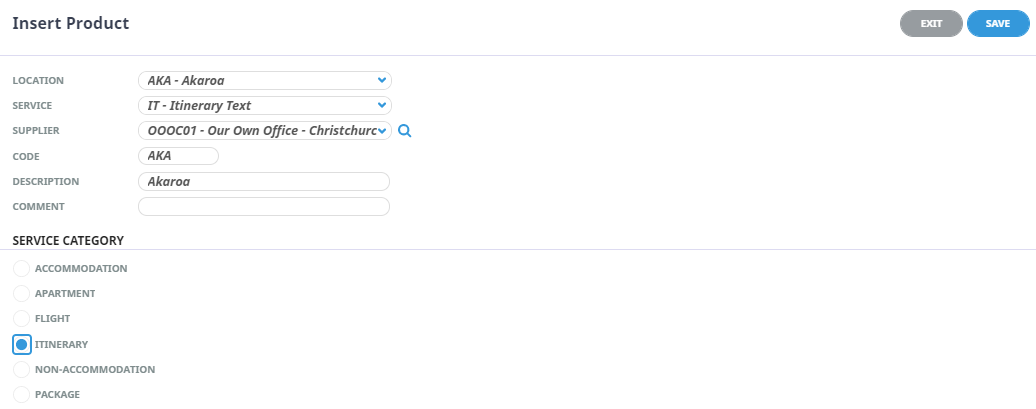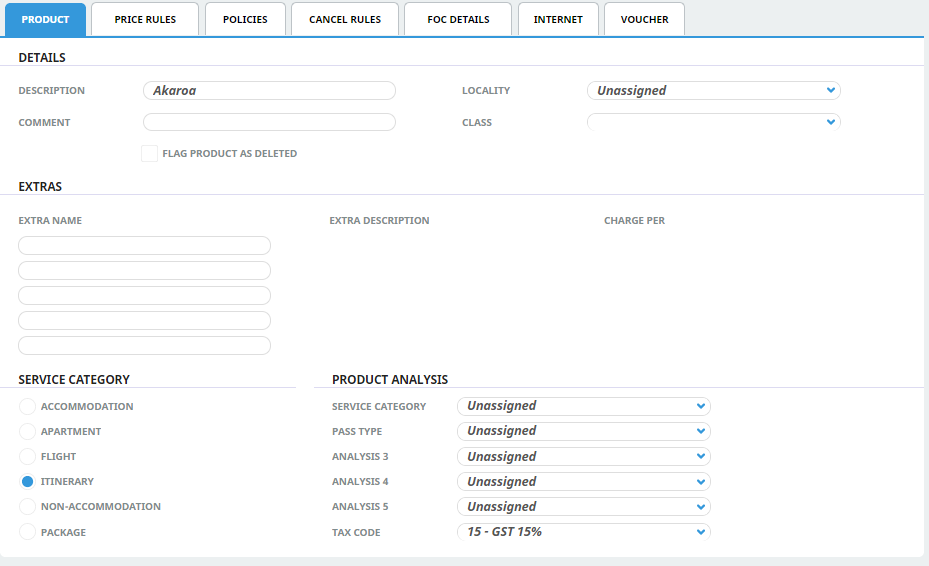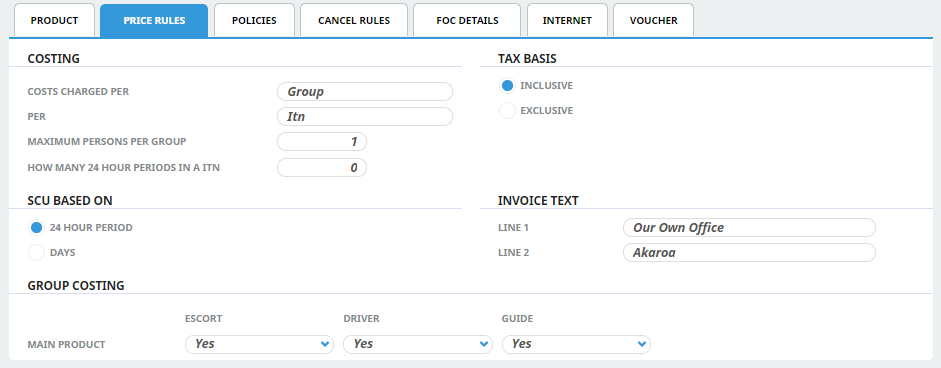Itinerary services can be used in a booking to store information not linked to a specific product. Information could include a welcome to a destination, or self drive instructions. Itinerary segments are first created in Code Setup and are linked to Itinerary service product (in this procedure). This allows an Itinerary product to be inserted as a service within a booking itinerary providing the order of content and where the information is to display when generating itinerary documents from a booking. System Setup configurations are required in conjunction with this proceedure, we suggest speaking with your local Tourplan Support office to learn more about implementing Itinerary Segments.
Itinerary Service Setup - Screen Overview
| Tab and Field | Description of Value Entered |
|---|---|
|
Product Setup/Product Tab |
|
|
Extras |
N/A |
|
Service Category |
Itinerary |
|
Product Setup/Price Rules Tab |
|
|
Costs Charged Per |
Per ‘Group’ per ‘Itn' |
|
Maximum persons Per Group |
1 |
|
How many 24 Periods in a Day |
0 |
|
SCU Based On |
Leave as default 24 hrs |
|
Group Costing |
Escort – Yes, Driver – Yes, Guide Yes |
|
Product Setup/Policies Tab |
|
|
Cross Season Policy |
N/A |
|
Product Setup/FOC Details Tab |
N/A |
|
Product Setup/Voucher Tab |
|
|
Print Voucher |
No Cost |
|
Voucher Creation |
One voucher |
|
Rates/Rate Set Tab |
|
|
Date Range |
Extended date range From Date - End |
| Rate Name | Standard |
|
Rates/Other Tab |
|
|
Service Voucher Text 1 - 10 |
N/A |
|
Content |
|
|
Amenities |
N/A |
|
Product Notes |
As required or Itinerary segment below |
|
Itinerary |
Select pre-loaded Itinerary Segment |
|
Operation/Message Defaults |
|
|
Message Format |
Relevant Itinerary related message format |
Create Itinerary Product
The first step to inserting product is to create the shell of the product into the database. The procedures which follow on allow further details to be inserted for this product.

Field Selections
Location (drop-down)
Select a location code from the drop-down list, or type the location code. Location codes must already be setup in the Code Setup application, Create a Product Location. If replicated locations are to be used, a generic location should be used.
Service Type (drop-down)
Select a service code from the drop-down list or type the Service Code. Service codes must already have been setup in the Code Setup application, Create a Product Service Type.
Supplier (drop-down)
Select a supplier from the drop-down list, or type the Supplier Code. Suppliers must already be setup in the Creditors application, Create a Supplier.
Code (6 Char, Autocaps)
Enter a Product Code. Examples of commonly used codes are:
- Itinerary
Itinerary Services code is a code of up to 6 characters, and is used to identify the itinerary segment information - e.g. AKLW - Auckland Welcome, AKLA - About Auckland, AKLD - Auckland Drive
Description (60 Chrs)
A one line description of the product.
Comment (60 Chrs)
A one line comment regarding this product can be entered. This field can be optionally displayed in the FITs, Groups and PCM programs when listing and searching for products.
Service Category
The product must have one of these radio buttons checked. The service category determines what data pre-populates some of the setup fields and enables the system to use logic specific to the category to correctly generate pricing.
| Radio Button | Definition |
|---|---|
| Itinerary | Identifies a service that has no pricing, but is used simply to carry itinerary text to be inserted into a booking/quote. |
Product Tab
Inserting Product Details allows the product to store a brief description of the service. These are the fields which will be available to consultants at the time of the booking. Amendments to the Description and Comments fields can be performed here.

Price Rules
Price Rules settings identify how the service is to be sold, itinerary services are not chargeable services and will have a 0.00 rate value attached to them. However for the service to be inserted into a booking an appropriate FCU and SCU will need to be entered.
This example shows: per Group, per Itn, with a maximum person per group of 1.

Voucher
There is no requirement to voucher Itinerary Services because there is no physical service reserved with a supplier. Eliminating the need for a voucher occurs from a section within the voucher tab called Print Vouchers. This is where services can be identified as 'No Cost' services.
Rates
There are 4 tabs which allow specific rate information to be stored per date range. An Itinerary Service only requires minimal data entry.
- Date Range - Unlimited date range which allows the system to insert the itinerary service for all future dates.
- Rates - Leave the service as a 0.00 rate entry.
This example shows the date range entered is 01 Oct 2010 - 31 Dec 2049. Having an unlimited date range allows the service to be inserted.

Content
This is the area which will store the necessary text information for your itinerary. There is more than one area where text can be written and included in itineraries.
- Product note text can be used in lieu of Itinerary Segments and language codes can be used for Itinerary messages, as with booking agent messages, and PCM agent messages. If note text is the preferred method of storage for your itinerary text you will need to insert the information as a Product Note.
- If Itinerary Segments are to be used the text will first need to be inserted into Code Setup > Product > Itinerary Segments allowing selection to occur within the product. Instructions on inserting Itinerary Segments.
NOTE: We suggest discussing these options with your local Tourplan Support office, as they will be able to identify the pros and cons for your organsiational needs.